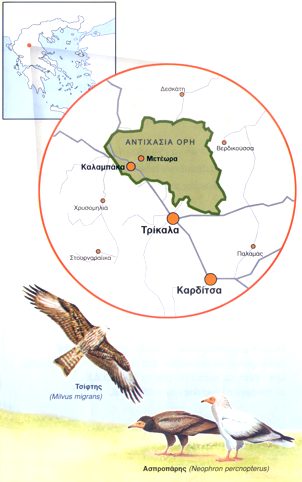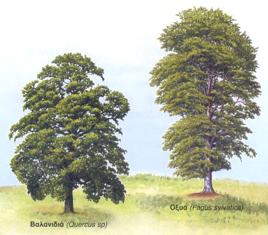 The biotope “Mount Antichasia-Meteora” occupies the largest part of the Antichasia Mountains, which are located in the northeastern part of the Prefecture of Trikala.
The biotope “Mount Antichasia-Meteora” occupies the largest part of the Antichasia Mountains, which are located in the northeastern part of the Prefecture of Trikala.
They are low mountains, their peaks are between 1000 and 1500m high. and are crossed by small mountain rivers, the most important of which are the Murganis and the Litheos, which are tributaries of the Pinios river.
The western part of the area includes the rocks of Meteora, which are located at a short distance north of Kalampaka and dominate the beginning of the valley of Pinios.
The protection area is a mosaic of different vegetation types with their sub-Mediterranean character as a common element. The diversity of vegetation is mainly attributed to over-sea altitude, parent rock and soil, exposure, horizon, human influence, etc.
The largest part (lower) of the area is covered by the para-mediterranean vegetation zone (Quercetalia pybescentis) and only a small part at the highest points is covered by the beech trees zone (Fagetalia).
The dominant forest species is Q. frainetto, which is often mixed with Q. cerris and Q. pybescens.
Two endemic species of flora appear in the area: Centaurea Kalabakensis and Centaura lactiflora.
The area is important for the avifauna because 46 species and subspecies of birds of section Ι of Directive 79/409 and 59 SPEC were recorded in it.
 The biotope is home to one of the last remaining colonies of the Shrike (Milvus migrans) in the whole country, a species that is threatened with extinction from Greece and Europe. Whereas the area is at the same time the most important area of Greece for the Egyptian Vulture (Neophron percnopterus) which is threatened with extinction in Europe.
The biotope is home to one of the last remaining colonies of the Shrike (Milvus migrans) in the whole country, a species that is threatened with extinction from Greece and Europe. Whereas the area is at the same time the most important area of Greece for the Egyptian Vulture (Neophron percnopterus) which is threatened with extinction in Europe.
As it satisfies other criteria and is located in a central point of the country, it is of great importance for the coherence of the network of protected areas.

